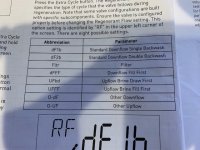xa1200
Member
Hey guys,
Where would Slow Rinse be used in a custom setting configuration? Since my brine tank is out in the sun, I would prefer it to fill first before regeneration and not after.
1.5cuft water softener, .25gpm, C36, H10
RF (I believe this is brine fill) 16
SP (service position - pause) 2:00
BW (backwash) 5
BD (brine draw) 60
RR (rapid rinse) 5
LC (last cycle)
I believe the dF1B configuration has brine draw and slow rinse built into step #2 but it doesn't list the time for each.
Where would Slow Rinse be used in a custom setting configuration? Since my brine tank is out in the sun, I would prefer it to fill first before regeneration and not after.
1.5cuft water softener, .25gpm, C36, H10
RF (I believe this is brine fill) 16
SP (service position - pause) 2:00
BW (backwash) 5
BD (brine draw) 60
RR (rapid rinse) 5
LC (last cycle)
I believe the dF1B configuration has brine draw and slow rinse built into step #2 but it doesn't list the time for each.
Last edited:

